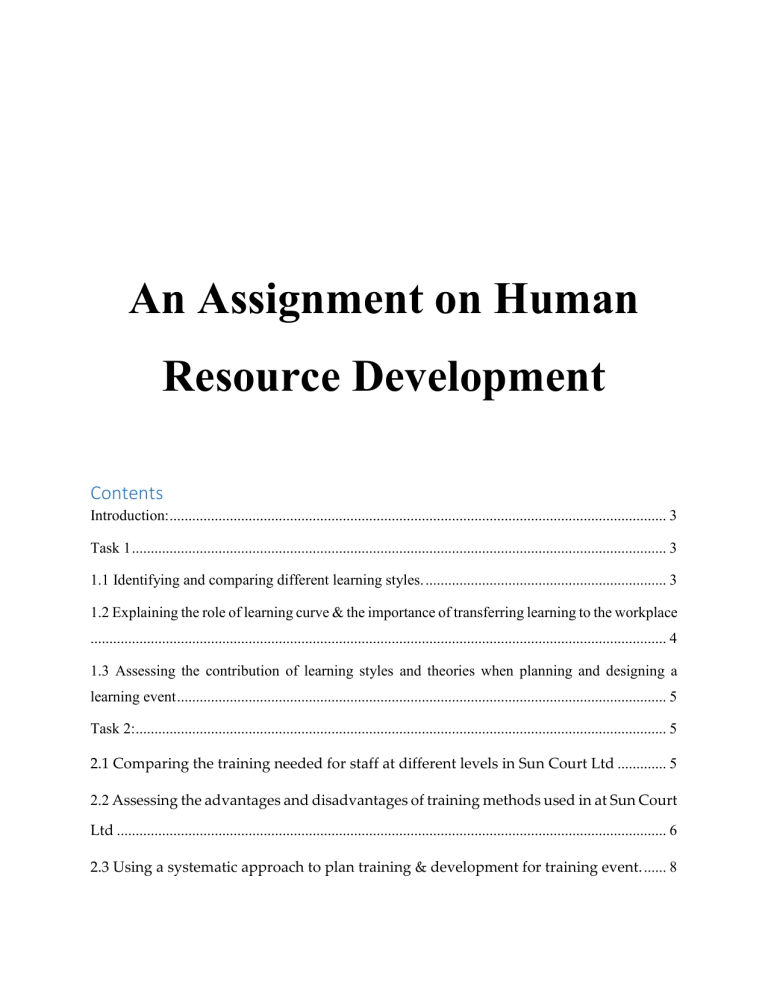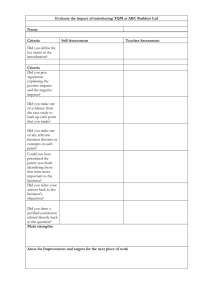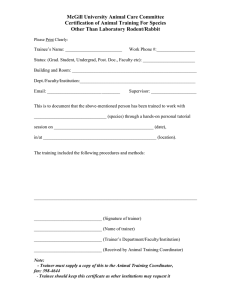
An Assignment on Human Resource Development Contents Introduction: .................................................................................................................................... 3 Task 1 .............................................................................................................................................. 3 1.1 Identifying and comparing different learning styles. ................................................................ 3 1.2 Explaining the role of learning curve & the importance of transferring learning to the workplace ......................................................................................................................................................... 4 1.3 Assessing the contribution of learning styles and theories when planning and designing a learning event .................................................................................................................................. 5 Task 2: ............................................................................................................................................. 5 2.1 Comparing the training needed for staff at different levels in Sun Court Ltd ............. 5 2.2 Assessing the advantages and disadvantages of training methods used in at Sun Court Ltd .................................................................................................................................................. 6 2.3 Using a systematic approach to plan training & development for training event. ...... 8 Task 3: ............................................................................................................................................. 9 3.1 Preparing an evaluation for a training event using suitable techniques ....................... 9 3.2 Carrying out an evaluation of a training event ............................................................... 12 3.3 Reviewing the success of the evaluation methods used ................................................ 13 Task 4 ............................................................................................................................................ 13 4.1 Explaining the role of government in training, development and lifelong learning . 13 4.2 Explaining how the development of the ................................................................................. 15 competency movement has impacted on the public and private sectors ...................................... 15 4.3 Assessing how contemporary training initiatives introduced by the UK government contribute to human resources development for an organization. ................................................................. 16 Conclusion: ................................................................................................................................... 16 Introduction: Human resource is the most important factor of any kind of organization. Developing these human resources is also very essential issue for the firm. Though human resources are asset to firm, unskilled and unqualified resources are liability. That’s why organization must provide necessary training and development. As both internal and external environment changes rapidly, human resources needed to be developed. Human resource development helps the firm to adapt with such changes through the development of human resources in terms of skills and knowledge. Through human resource development process, employees will fill committed to work and it leads to job satisfaction. HR development provide proficient and competent employees to the firm. HR development can provide employee that remain committed to the firm. for managing conflict, culture, environment it seems to be useful. It also useful for change management. Sun Count Residential Homes Limited is a firm that provide up a market care home for old people age over 60 years. They provide 50 rooms for the aged people. Task 1 1.1 Identifying and comparing different learning styles. Learning means changing behavior influenced by experience. Learning styles varies from person to person. A particular person may follow a learning style that another person will not follow. Also each person is not confined to or restricted to only one learning style but they may follow different learning style. Few learning style is correspondent to specific situation therefore there are different types of learning styles for different circumstances. Learning techniques are influenced by some factors that distinguish one person from another (Fiol and Lyles ,1985). From the company's induction training program to take into account different types of learning styles are: pragmatists, activists, theoretic, reflector. Pragmatists: In pragmatic style, both employer and employees try to run through practical experience and tips. Some activities of pragmatists are paired discussion, self-analysis questionnaires, observing activities, coaching etc. Activists: in this learning style employee learn by doing things and participating in activities. Some activities are brainstorming, problem solving, group discussion, competitions etc. Theoretic: in this learning style employees and employers learn by understanding theories very clearly and maintain them strictly. Some activates are case studies, problem solving etc. Reflector: in this style employees learn by watching other and they think before act. They act like opportunists and optimists (Curry,1983). For developing human resource for Sun Count Residential Homes Limited, they use pragmatists and activists learning style. 1.2 Explaining the role of learning curve & the importance of transferring learning to the workplace Learning curve is a graph that shows the relation between time spent on learning and the progression of nous based on its level. Learning is presented in vertical axis and experience is presented in horizontal axis. Learning curve basically state that if one learns more, he needs less step to increase effort and experience. Only if the employees are motivated, there may be a possibility of getting best utilization of learning. If there is none, there may be imbalance between learning and ultimate performance (Spence, 1981). Transfer of learning: Utilizing previous learning in the service of new learning can be called transfer of learning. The ultimate aim of transferring learning into workplace is improving work condition. Each organization need to make a system by which learning can be successfully be transferred to implementation. Among different systems, training is very popular method of relocating knowledge (Perkins and Salomon,1992). Learning curve effect: individual’s performance reflected in learning curve. It helps to share knowledge, skills and experience between employee and employer. Sun Count Residential Homes Limited trains the worker for achieving the goal of the firm. The administration also facilitates every requirement regarding this fact. 1.3 Assessing the contribution of learning styles and theories when planning and designing a learning event Knowledge is important for any type of business. If knowledge of employers is not being shared with employees, then that knowledge has little value for the firm. So, to gain success or to achieve competency, knowledge has to be shared. Learning theory and learning style help the firm to share this knowledge effectively across the firm. but choosing learning style is quite a critical factor for the manager as it depends on employees who will adopt with it. Time period of transferring knowledge is also important factor. It is very important to select correct learning style and theories to transfer knowledge (Coenen and others ,2006). Moreover, single style of learning may not be appropriate for each program. Manager must use multiple or combination of different learning style to disseminate knowledge to the employees. Trainer need to observe the behavior of different employee and he also need to observe different learning style then he has to decide which learning event he will set. Learning theories offer different type of learning style and nature of human behavior. By learning theories trainer can easily understand the nature of employee and their requited learning event (Curry,1983). Task 2: 2.1 Comparing the training needed for staff at different levels in Sun Court Ltd The need for training varies from level to level in an organization. People who are hired in the firm lacks different types of knowledge that is important for carry out daily activities. The employees of management level require some kind of knowledge whereas operational level employees require other type of knowledge. Organization need to provide employees with training when and where required. Training provide skillful employees to the firm that are essential for achieving organizational goal (Goldstein, 1980). The need for training in different level of organization is given below: Management level: Manager take different type of strategic decision for the firm. Training provide them with skill and competency by which they can make decision efficiently and effectively. The future of the firm depends on the strategic decision of the managers. If manager fails to make effective decision, the firm will fail to achieve its goal. Customer level: Training is needed for this level for making good communication with the customer. If organization fails to communicate with customers, they will eventually lose them. Operational level: Training is needed specially for this level. Because these level employees actually work for the firm. Direct training is given by line manager or the first level manager (Kotey & Slade, 2005) 2.2 Assessing the advantages and disadvantages of training methods used in at Sun Court Ltd Employees need to qualified enough and more dedicated to work to remain in the firm. So, Sun Court Ltd provide employees with training method and development opportunities. Training methods are the systems by which employer provide training to the employees. Organization use multiple method of training to train the employees at different level. Training methods are of actually two types, one is on job training and another is off job training (Beckhard, R.,1969). Training methods have both advantages and disadvantages and they are given below: Training Advantages Disadvantages method Performance Recognize performance of the It is very difficult to measure performance Appraisal employee and provide training for skill with standard, Some time employee development Discussion become demotivated Manager share organizational goal and Different point of view some time creates values and Employees can share skills conflict. and knowledge and set their own goal If both parties don’t participate , wrong goal may be set by them. Workshop Practical experience can improve It is costlier than other training methods efficiency and expertise. and less people participate in it Effective in nature. Coaching It is used to improve efficiency of the Coach Biasness may occur which results employee. in inefficient training. Employees gain practical knowledge and can develop their week areas. Role paying Understand the different job context Some being confused with different and gain knowledge about different responsibility. responsibility. Expensive in nature Reluctant to switch role (Koike, K., 1997) 2.3 Using a systematic approach to plan training & development for training event. The CEO of Sun Court Ltd. Thought Human Resource Management department impractical. But his thinking about HRD changes with time. At first he thought training employee cost is unnecessary which should be kept minimum. But due to central government pressure about his business and after attending a seminar his thinking has been changed, He now wants to train up the employee to survive in the competitive and challenging market. Most of the employees of his company lack long term commitment with the job. They also lack work related skill and for this company is facing challenges day by day. For this reason, CEO has hired a HR consultancy firm to look out these matters. A systematic approach to plan a training and development program for the event includes some steps like (Bartonand Delbridge ,2004) Employees join in a group discussion come up again after corrected situation Performance observe and correction Figure 1: Process of Training Event Problems identified and presented Solution is given by Top management Employees join in a group discussion: in this level all employees join in a discussion, then they talk about work and different work related activities. There may be present a trainer for employee. Problems identified and presented: After starting discussion, there may arise few problems. In this level problems are identified and presented to the superiors. Solution given: after identifying problem: top management discuss the problem and they provide solution to that problem. Performance observe and correction: in this step performance of employee after giving solution is analyzed and if there is any more problem in employee’s activities, they are corrected. Come up again after corrected situation: after corrected situation employees work accordingly. If some arise new problem, then they again call a discussion. Task 3: 3.1 Preparing an evaluation for a training event using suitable techniques To know the effectiveness of training program, evaluation of training is very essential. We need to answer few question to know about these aspects. Top management want to know how effective the training event is, they also want to evaluate different factors and components. I used Five tiered approach defined by Jacob f. (1988) to analyze whether the training program conducted was required or not required. Need assesment program impact Monitoring and Accountability progress program clarification Figure 5: Evaluation of training event Need Assessment: Here the need for program is identified and develop program to meet that demand. This is first step of evaluating training event. Monitoring and accountability: in this step participants are monitored by concerned individual. Program Clarification: it states the evaluation of program at various level and then clarifying it. Progress: Overall progress of the participants are measured in this steps. Program Impact: long and short term impact of program is measured and identified (Ridder, G., 1986). Methods of evaluation: Observation: Organization needs to observe employee to evaluate their performance after training has been finished. By observing organization gets information about employee and their performance level and effectiveness of training. Feedback: Feedback is received both from trainer and trainee. Feedback is actually of two types. Positive feedback and negative feedback. If trainer and trainee give positive feedback, then training program is successful. Comparison: the work of trainee after training is compared with other employee to find out the effectiveness of the training program. Customer Comment: The success of training program lies on whether the employee can use it in his workplace or not. If customer comment is positive about service, then training has accomplished its goal (Kirkpatrick, 1967). 3.2 Carrying out an evaluation of a training event Evaluation of training program means estimating the progress and effectiveness of training program that has been conducted to improve the quality and skill of the employees. Evaluation can be done by four ways: reaction, learning, behavior, result. Reaction: At this level, the organization looks the reaction of the participants in a training session. The reaction of the employees of the sun court ltd was positive toward training. They were eager to learn new things. By training they seems to get motivated. Learning: In this level, it is measured whether they are learning or not. In the case of Sun Court Ltd, viewing the feedback of trainer and trainee, they seem to learning. They have interest for learning for new things, new kills, new knowledge. Behavior: Behavior of employee tells us the effectiveness of training. If their behavior is positive, then the training program is fruitful. Result: Results are the practical performance of the employee after training. If they are doing their work according to policy and regulations, training program can be said to be successful (Phillips, and Phillip., 2016) 3.3 Reviewing the success of the evaluation methods used To determine the need of the training event, the five tier approach has been used. We need to answer many questions to identify the need of training event. In Sun Court ltd case, the induction program was conducted to instruct the new employees about their vision and mission, the policy of the company, the structure of the company. This induction program has also increased their working skill. The program was successful effectively training their employee. By feedback, observation and comparison we can understand the effectiveness of the training. The feedback from trainer and trainee and customer was positive. that’s mean the induction program was successful (Brinkerhoff, 2005.) Task 4 4.1 Explaining the role of government in training, development and lifelong learning UK government is playing a significant role in training and developing human assets both in public and private sector. The government is providing facilities conducted by specialists and experts regarding human resource development. These expert trainers provide proper knowledge to the employee of the firm. the ultimate of the government of the UK is to provide minimum basic skill and knowledge about work in their workplace. Sun Court ltd is a company that has a bright future in the economy. So the need government assistance to conduct business more successfully so that they can contribute more to the economy of the country. The government may provide them national apprenticeship. By apprenticeship, government helps the companies to train up apprentice by many training program. Lifelong learning is another important factor for providing knowledge. It educates the employees at every step to improve their skill. It supports the employers to invest in developing the efficiency and excellency of the employees. The aim of lifelong learning is to increase the participation of employers and employees in training. Lifelong learning is responsible for development of learning, further education, higher education etc. lifelong learning has some strategic goal. One is to develop learning and skill solutions. Second is encouraging the employer to invest more in the training sector. Third is providing respected labor market to the employer and the final one is enhancing the quality of learning programs (longworth.1986) 4.2 Explaining how the development of the competency movement has impacted on the public and private sectors If we observe closely we will see the development of competency movement around the world including UK. Competency movement means getting competitive advantage in doing business over others. This competency movement forces the company or organizations to train up their employee in terms of skills and knowledge. There are some factors that accelerates the competency movement. These factors make the employee of the company to become competent in the market. Now a day’s firms are investing more and more to avoid competitive disadvantage and to gain skill and to improve service quality. Proper job description allows the company’s employees to learn and their job and their responsibility. Overall explanation of job and duties is described in job description. Before conducting training, training need analysis need to be done. When recruiting employees, organization need to evaluate their skill regarding the job. It is the duty of the company to develop social skill for the employees. Private sector is facing more competition now-a-days as there are a lot of substitute product or service available in the market. That’s why private sector wants to invest more to develop skills so that they can survive in the market. A private company like Sun Court Ltd invest hugely to gain competitive advantage. Investing in HRD makes individual competent and increase company’s performance as well. They take customer complains. reviews them and then develop the employees as requirement. Sun Court Ltd maintains friendly and attached relationship with employees. It acts like motivation. For this reason, employees feel coworkers as family. Improved performance increases job satisfaction. Along with private sector, public sector is getting involved in developing human resource. Without doing this they cannot keep pace with the competitive market. They are making high performance and consistent improvement. This never ending process of learning drives to higher success of organizations (Horton,2000). 4.3 Assessing how contemporary training initiatives introduced by the UK government contribute to human resources development for an organization. UK government has taken many initiatives for small and medium organizations to improve the performance of the employee. They provide programs including National Vocational Qualification, Apprenticeship, Train to gain, Investors in people. National Vocational qualification: the company that acts according to the standard, national vocational qualification gives them award. Apprenticeship: Apprenticeship is the training program for the fresher conducted by different organizations Train to gain: government funded program to train up employee in UK based organizations Investors in people: Investors in people is a framework that set a standard for the training management These programs of UK government train the employee of the firm for increasing performance which will eventually contribute to the national income. The ultimate aim of these various program conducted by government is to give the employee minimum working standard. By providing proper training, productivity of UK employees increases (Hill and Stewart,2000). Conclusion: Different people adopt different types of learning method. The training event for the employee based on the behavior of the employee and their learning style. Training event is a planned process that needed to be done effectively to get maximum result. Organizations use various method to train up the employee. Training events depends on training need which manager should analysis before training. The effectiveness of training program is evaluated by feedback, observation and performance check. As environment is unpredictable, organizations must keep their employees up to date with every knowledge so that in hard time they can serve efficiently. To cope with changing environment organization should develop skills and knowledge of employee. Human resource development program acts as motivation for the employee. This motivation eventually increases job performance which leads to job satisfaction. If employee knows what his responsibility is, he can perform his duties more effectively.it is only possible through human resource development program. Human resource development also used for managing conflict, increasing labor management decision and developing organizational health and sound culture. References: Fiol, C. M., & Lyles, M. A. (1985). Organizational learning. Academy of management review, 10(4), 803813. Curry, L. (1983). An Organization of Learning Styles Theory and Constructs. Spence, A. M. (1981). The learning curve and competition. The Bell Journal of Economics, 49-70. Perkins, D. N., & Salomon, G. (1992). Transfer of learning. International encyclopedia of education, 2, 6452-6457. Coenen, L., Moodysson, J., Ryan, C.D., Asheim, B.R. and Phillips, P., 2006. Comparing a Pharmaceutical and an Agro‐food Bioregion: On the Importance of Knowledge Bases for Socio‐spatial Patterns of Innovation. Industry and Innovation, 13(4), pp.393-414. Curry, L. (1983). An Organization of Learning Styles Theory and Constructs. Goldstein, I. L. (1980). Training in work organizations. Annual review of psychology, 31(1), 229-272. Kotey, B. and Slade, P. (2005), Formal human resource management practices in small growing firms*, Journal of small business management, 43(1), 16-40. Beckhard, R. (1969). Organization development: Strategies and models. Koike, K., (1997). Human resource development (No. 2). Tokyo: Japan Institute of Labour. Barton, H. and Delbridge, R., 2004. HRM in support of the learning factory: Evidence from the US and UK automotive components industries. The International Journal of Human Resource Management, 15(2), pp.331-345. Ridder, G., 1986. An event history approach to the evaluation of training, recruitment and employment programmes. Journal of applied econometrics, 1(2), pp.109-126. Phillips, J.J. and Phillips, P.P., 2016. Handbook of training evaluation and measurement methods. Routledge. Brinkerhoff, R.O., 2005. The success case method: A strategic evaluation approach to increasing the value and effect of training. Advances in Developing Human Resources, 7(1), pp.86-101. Longworth, N. and Davies, W.K., 1996. Lifelong Learning: New Vision, New Implications, New Roles for People, Organizations, Nations and Communities in the 21st Century. Kogan Page Limited, 120 Pentonville Rd., London N1 9JN, England, United Kingdom.. Horton, S., 2000. Introduction–the competency movement: Its origins and impact on the public sector. International Journal of Public Sector Management, 13(4), pp.306-318. Hill, R., & Stewart, J. (2000). Human resource development in small organizations. Journal of european industrial training, 24(2/3/4), 105-117.


